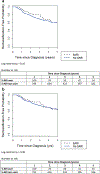Continued 5α-Reductase Inhibitor Use after Prostate Cancer Diagnosis and the Risk of Reclassification and Adverse Pathological Outcomes in the PASS
- PMID: 30076904
- PMCID: PMC10958899
- DOI: 10.1016/j.juro.2018.07.065
Continued 5α-Reductase Inhibitor Use after Prostate Cancer Diagnosis and the Risk of Reclassification and Adverse Pathological Outcomes in the PASS
Abstract
Purpose: Outcomes in patients who enroll in active surveillance programs for prostate cancer while receiving 5α-reductase inhibitors have not been well defined. We sought to determine the association of 5α-reductase inhibitor use with the risk of reclassification in the PASS (Canary Prostate Active Surveillance Study).
Materials and methods: Participants in the multicenter PASS were enrolled between 2008 and 2016. Study inclusion criteria were current or never 5α-reductase inhibitors use, Gleason score 3 + 4 or less prostate cancer at diagnosis, less than a 34% core involvement ratio at diagnosis and 1 or more surveillance biopsies. Included in study were 1,009 men, including 107 on 5α-reductase inhibitors and 902 who had never received 5α-reductase inhibitors. Reclassification was defined as increase in the Gleason score and/or an increase to 34% or greater in the ratio of biopsy cores positive for cancer. Adverse pathology at prostatectomy was defined as Gleason 4 + 3 or greater and/or nonorgan confined disease (pT3 or N1).
Results: On multivariable analysis there was no difference in reclassification between men who had received and those who had never received 5α-reductase inhibitors (HR 0.81, p = 0.31). Patients who had received 5α-reductase inhibitors were less likely to undergo radical prostatectomy (8% vs 18%, p = 0.01) or any definitive treatment (19% vs 24%, p = 0.04). In the 167 participants who underwent radical prostatectomy there was no suggestion of a difference in the rate of adverse pathology findings at prostatectomy between 5α-reductase inhibitor users and nonusers.
Conclusions: Continued 5α-reductase inhibitor use after an initial diagnosis of prostate cancer was not associated with the risk of reclassification on active surveillance in men in the PASS cohort.
Figures
Comment in
-
Editorial Comment.J Urol. 2019 Jan;201(1):112. doi: 10.1097/01.ju.0000550164.56925.06. J Urol. 2019. PMID: 30577401 No abstract available.
References
-
- Thompson IM, Goodman PJ, Tangen CM et al.: The influence of finasteride on the development of prostate cancer. N Engl J Med 2003: 349: 215. - PubMed
-
- Andriole GL, Bostwick DG, Brawley OW et al.: Effect of dutasteride on the risk of prostate cancer. N Engl J Med 2010: 362: 1192. - PubMed
-
- United States Food and Drug Administration: FDA Drug Safety Communication: 5-alpha reductase inhibitors (5-ARIs) may increase the risk of a more serious form of prostate cancer. Available at http://www.fda.gov/drugs/drugsafety/ucm258314.htm. Accessed January 12, 2017.
-
- Roehrborn CG, Andriole GL, Wilson TH et al.: Effect of dutasteride on prostate biopsy rates and the diagnosis of prostate cancer in men with lower urinary tract symptoms and enlarged prostates in the Combination of Avodart and Tamsulosin Trial. Eur Urol 2011; 59: 244. - PubMed
-
- Sanda MG, Chen RC, Crispino T et al.: Clinically Localized Prostate Cancer: AUA/ASTRO/SUO Guideline. Linthicum: American Urological Association; 2017.
Publication types
MeSH terms
Substances
Grants and funding
LinkOut - more resources
Full Text Sources
Other Literature Sources
Medical


